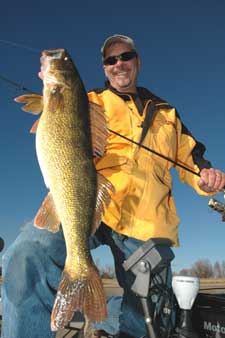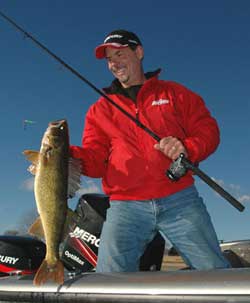 Tweak it, modify it, fine tune it, and dial it in … that’s what makes a good fish catching presentation even better. Pushing the envelope … pushing the fish to their limit … to the point where you’ve optimized the bite! By pushing fish I’m talking about fishing with an attitude … a mind set in that you’re going to find out just exactly what the absolute best presentation is going to be to trigger the most bites on a given day.
Tweak it, modify it, fine tune it, and dial it in … that’s what makes a good fish catching presentation even better. Pushing the envelope … pushing the fish to their limit … to the point where you’ve optimized the bite! By pushing fish I’m talking about fishing with an attitude … a mind set in that you’re going to find out just exactly what the absolute best presentation is going to be to trigger the most bites on a given day.
That said, being a successful angler doesn’t necessarily mean changing lures and tactics constantly at times when you’re not getting bit. Obviously however, if you aren’t getting any fish, “some” changes are in order. I see many anglers start messing around with presentations when the fish just aren’t biting anything they’re trying. Their thinking is that if they aren’t getting bites, then it must be the presentation. More often than not however, the reason they aren’t getting bites is because they aren’t fishing the right fish … if they’re fishing fish at all.
So how do you push fish? Well the first order of business is finding fish. If you’re not catching fish, it’s pretty tough to start pushing them. But once you’ve located a school and begun to put together a pattern that’s working … let the pushing begin. Pushing is fine-tuning… discovering just how much variation from a successful pattern the walleyes (or any fish for that matter) will tolerate before they turn their noses away from your offerings.
For instance: You’re popping walleyes trolling bottom bouncers and spinners along a twelve foot break at three quarter mph. The fish are hitting pretty good so you can conclude they’re fairly aggressive … so you decide to go with a more aggressive approach. You reel in the spinners and pull out your lead core rods and tie on small, medium action crankbaits and start trolling the area at 1 to 1.5 mph. The results are encouraging … you’re still catching fish, but now you’re covering water quicker and putting more fish in the boat in a shorter amount of time. Ok … so now push things a little more … try running larger crankbaits on straight FireLine trolling at 2 to 2.5 mph. Now you’re really covering water, but your bite ratio decreases significantly, a sign that you’ve probably pushed things a little too far.
 That’s the pushing process … it’s all about fine tuning the presentation. So how many variables can be fine tuned? All of them! Primarily though, you’re dealing with factors that influence how your baits react in the water … lure size, lure weight, line diameter, line type, boat speed. Even water clarity has an affect because that could determine what color might be the best, or whether or not a rattling bait will be more productive or not.
That’s the pushing process … it’s all about fine tuning the presentation. So how many variables can be fine tuned? All of them! Primarily though, you’re dealing with factors that influence how your baits react in the water … lure size, lure weight, line diameter, line type, boat speed. Even water clarity has an affect because that could determine what color might be the best, or whether or not a rattling bait will be more productive or not.
The point is to keep an open mind … always asking yourself “Is there another way I can catch these fish better, faster, and more effectively. If you’re catching fish slowly drifting slip sinker rigs using three inch minnows, then try trolling a bottom bouncer or 3-way rig tipped with those same minnows…by trolling you’re increasing your boat speed and could catch the walleyes faster. If you’re nailing walleyes vertical jigging green eighth ounce jigs tipped with half a crawler, try quarter ounce jigs tipped with plastic, put a little more “pop” in your jigging action and increase your boat speed.
Then there’s the human factor when it comes to such presentations such as pitching or vertical jigging where the angler has hands-on control of the action put on the lure. Some days a very subtle “lift-drop” will be the ticket … other days adding a more aggressive “pop” to the jig will trigger more bites. Even when casting crankbaits, there’ll be times when a slow, steady retrieve will trip their trigger and other days that reeling the bait in fast with a few added “twitches” thrown in will be the best way to get bit.
Pushing your own boundaries is another part of the game that can help you dial in a great presentation. Most walleye anglers are very comfortable fishing in depths from ten to thirty feet. There are many instances throughout a season however that pushing yourself to fish outside your comfort zone will bring you significant rewards. You may spend the better part of a morning catching good numbers of nice walleyes on a series of main lake points in fifteen feet of water only to have the bite taper off half way through the day. It may be easy to say to yourself “They just turned off.”, when in fact the fish made an adjustment. You may find that they’ve moved shallow on those points, and pitching small jigs in a foot or two of water will put you back on the bite, or they may have slid down the break and are stacked up in forty, fifty, maybe even sixty feet of water … still catchable, but only if you make your own adjustments.
Rule number One – find the fish. Rule number Two – catch the fish. Rule number Three – if you’ve successfully completed Rules One and Two, then its time to start the tweaking process and push those fish as far as they’ll let you. Do that and you’ll find yourself catching more and bigger walleyes … and any other fish you go after for that matter.










